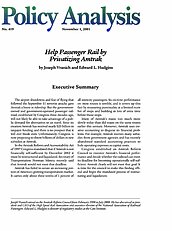The airport shutdowns and fear of flying that followed the September 11 terrorist attacks gave Amtrak a boost in ridership. But the government-owned and government-operated passenger railroad, established by Congress three decades ago, will not likely be able to take advantage of a public demand for alternatives to air travel. Since its creation Amtrak has received nearly $25 billion in taxpayer funding, and there is no prospect that it will ever break even. Unfortunately, Congress is now proposing to throw billions of dollars in new subsidies at Amtrak.
In the Amtrak Reform and Accountability Act of 1997 Congress mandated that if Amtrak is not financially self-sufficient by December 2002 it must be restructured and liquidated. Secretary of Transportation Norman Mineta recently said that Amtrak would not meet that deadline.
Amtrak has failed to secure an increasing portion of Americas growing transportation market. It carries only about three-tenths of 1 percent of all intercity passengers. Its on-time performance on most routes is terrible, and it covers up this fact by measuring punctuality at a limited number of stops and building in lots of extra time before those stops.
Many of Amtrak’s trains run much more slowly today than did trains on the same routes earlier this century. Moreover, Amtrak uses creative accounting to disguise its financial problems. For example, Amtrak receives many subsidies from government agencies and has recently abandoned standard accounting practices to hide operating expenses as capital costs.
Congress established an Amtrak Reform Council to monitor Amtraks financial performance and decide whether the railroad can meet its deadline for becoming operationally self-sufficient. Amtrak clearly will not meet that goal. It is time for the council to make this finding official and begin the mandated process of restructuring and liquidation.
About the Authors

This work is licensed under a Creative Commons Attribution-NonCommercial-ShareAlike 4.0 International License.
